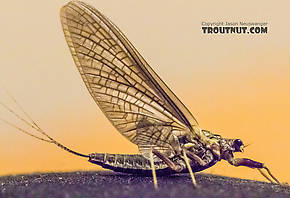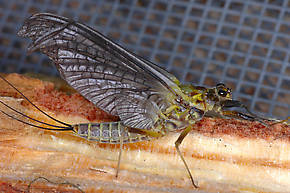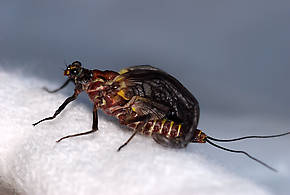Blog & Latest Updates
Fly Fishing Articles
Insects by Common Name


Mayfly Species Drunella grandis (Western Green Drake)
Taxonomic Navigation -?-
Kingdom
Animalia (Animals)
» Phylum
Arthropoda (Arthropods)
» Class
Insecta (Insects)
» Order
Ephemeroptera (Mayflies)
» Genus
Drunella (Blue-Winged Olives)
» Species grandis (Western Green Drake)
Common Names
It hasn't been all that many years since Western traditions and entomological "facts on the ground" began to influence the angler's lexicon heavily dominated by Eastern writers. Their initial reporting after visiting the region first popularized the phrase "Rocky Mountains answer to the popular Green Drakes of the East". This led to a false impression that lingers to this day. The reality is these giants of their family have abundant populations all over the West with no counterpart in the East, and the West does have abundant hatches of comparable Ephemeridae. The Western tradition of naming outsized Mayflies "Drakes" is the reason for what many consider a misnomer by giving it the same common name as the legendary Ephemerid of the East and surely contributed to confusion for anglers unconcerned with such subtleties.
Where & When
The Western Green Drakes are very widespread and important, causing some of the best fishing of the season throughout their range, from Yellowstone to California to Alaska.
Caucci and Nastasi report that this hatch begins and ends a few weeks earlier on spring creeks, where they are especially prolific, than on freestone rivers.
Hatching Behavior
Time Of Day (?): Variable
Habitat: They prefer to emerge from calm places near their fast-water nymphal habitat.
Water Temperature: Starts at 50°F, peaks at 55-60°F
These duns take an exceptionally long time to get airborne once they break through the surface, and they may make several clumsy attempts.Habitat: They prefer to emerge from calm places near their fast-water nymphal habitat.
Water Temperature: Starts at 50°F, peaks at 55-60°F
Emergence may occur late in the morning early in the year or at high altitudes, but it progresses through the afternoon and into the evening as the season heats up. Most authors suggest that the best fishing at the peak of the hatch is in the evening, but others say the best hatching is in the early to mid-afternoon. All agree that it can last for several hours on a good day.
Like all common Drunella species, these duns quickly change color once they're exposed to the air. Anglers should imitate the bright green of the freshly emergent duns rather than the dark ruddy brown color they display later.
Spinner Behavior
According to Hatches II, spinner flights are most common during the day:
The initial spinner flights of these species may occur at midday. As the weather climbs into the 80's and 90's, they will progressively fall later until they occur at dusk. In August, the spinner flight may take place during mid-morning...
However, according to Mayflies: An Angler's Study of Trout Water Ephemeroptera and Mayflies, the Angler, and the Trout, the spinners are active in the middle of the night. Arbona writes:
Daytime spinner flights are very sparse for such a common species because the large spinners do not become active until well after nightfall, and ovipositing is accomplished at 4am.
Most angler reporting concurs with the latter.
Nymph Biology
Current Speed: Medium to fast
Most sources suggest these mayflies inhabit medium to fast water, but they are common inhabitants of many spring creeks as well. To name just a few - Hat Creek and Fall river in CA., the Metolius River in OR., and the famous Henry's Fork in ID. where they have legendary status.Like others in the Ephemerellidae, these nymphs often swim to and from the surface several times prior to emerging, and imitating this behavior is effective in the hours before the hatch. There is also evidence that the duns often emerge subsurface as well. This is given testimony by the frequent success of emerging dun wet flies.
Drunella grandis Fly Fishing Tips
As with the Eastern hatches of Isonychia bicolor, trout become strongly conditioned to watch for these meaty duns on the surface. Their imitations make excellent attractor (Attractor: Flies not designed to imitate any particular insect, but to incorporate characteristics attractive to trout. When trout aren't feeding selectively, attractors often outperform careful imitations as searching patterns because they are easier to see and incorporate more strike-triggering characteristics. They include legends like the Adams, Bivisible, and Royal Wulff.) flies on days when their hatch is off or even after it has ended.
Pictures of 12 Mayfly Specimens in the Species Drunella grandis:
Female Drunella grandis (Western Green Drake) Mayfly Dun View 6 PicturesI collected this specimen while away from all my good photography equipment except the camera and one of my macro lenses, so I made do. The lighting is from lamps in a hotel room, so it was hard to edit for really true colors, but I tried to get as close as possible. The body was 13 mm long, wing 19 mm long.
View 6 PicturesI collected this specimen while away from all my good photography equipment except the camera and one of my macro lenses, so I made do. The lighting is from lamps in a hotel room, so it was hard to edit for really true colors, but I tried to get as close as possible. The body was 13 mm long, wing 19 mm long.
 View 6 PicturesI collected this specimen while away from all my good photography equipment except the camera and one of my macro lenses, so I made do. The lighting is from lamps in a hotel room, so it was hard to edit for really true colors, but I tried to get as close as possible. The body was 13 mm long, wing 19 mm long.
View 6 PicturesI collected this specimen while away from all my good photography equipment except the camera and one of my macro lenses, so I made do. The lighting is from lamps in a hotel room, so it was hard to edit for really true colors, but I tried to get as close as possible. The body was 13 mm long, wing 19 mm long.Collected July 14, 2017 from the American River in Washington
Added to Troutnut.com by Troutnut on July 24, 2017
Added to Troutnut.com by Troutnut on July 24, 2017
Female Drunella grandis (Western Green Drake) Mayfly Dun View 3 Pictures
View 3 Pictures
 View 3 Pictures
View 3 PicturesCollected June 29, 2007 from the Jocko River in Montana
Added to Troutnut.com by Bnewell on June 28, 2011
Added to Troutnut.com by Bnewell on June 28, 2011
Your Thoughts On Drunella grandis:
Top 10 Fly Hatches
Top Gift Shop Designs
Eat mayflies.
Top Insect Specimens
Miscellaneous Sites
Troutnut.com is copyright © 2004-2024 Jason
Neuswanger (email Jason). See my FAQ for information about use of my images.
 privacy policy
privacy policy

